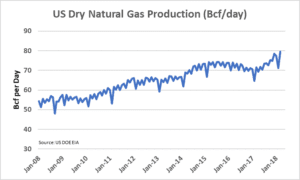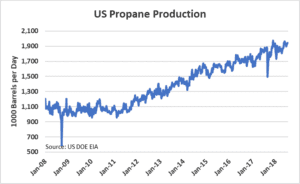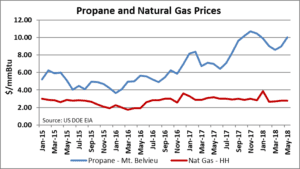Propane and Natural Gas – Birds of a Feather Not Flying Together
Propane is a versatile source of energy common in rural areas that are “beyond the main” of utility natural gas service. It is often used for home space and water heating and cooking, as well as for agricultural uses such as crop drying, irrigation pump fueling, space heating in green houses, pig and poultry brooding, frost protection, standby electricity generation, and even food refrigeration.
Where does propane come from?
Propane is produced in association with natural gas (along with other natural gas liquids, or NGLs) and is also a byproduct of crude oil refining. Because propane is a gas at atmospheric pressure, it is compressed into a liquid state under moderate pressure for storage and delivery.
The shale gas revolution has led to dramatic increases in natural gas production.

As previously reported, US natural gas prices have remained low for some time. This is despite the existence of many influences that more recently would have driven natural gas prices upward (see Natural Gas Market Update, June 2018).

Because propane is produced in association with natural gas, along with the dramatic increase in US natural gas production has come a dramatic increase in US propane production. As natural gas production has increased, so has NGL production.

With such an increase in propane supply, propane prices, like natural gas prices, are low – right?
No.
While natural gas prices have remained low (red line below), propane prices have risen significantly (blue line below).


Why?
Exports of propane from the US have grown and continue to grow.

Conclusion
Rural residential and agricultural customers who rely on propane rather than natural gas are not benefiting from the shale gas revolution to the extent that others are in the US. Increasing propane exports are a major driver of this phenomenon. This is another illustration of the complicated dynamics underlying energy commodity markets and an example of how those markets can change over time, often in unexpected ways.
Note: Evelyn Teel contributed to this article.
The Avalon Advantage – Visit our website atwww.avalonenergy.us, call us at 888-484-8096, or email us atinfo@avalonenergy.us.
Please feel free to share this article. If you do, please email or post the web link. Unauthorized copying, retransmission, or republication is prohibited.
Copyright 2018 by Avalon Energy®Services LLC
